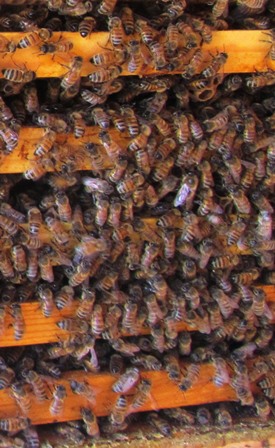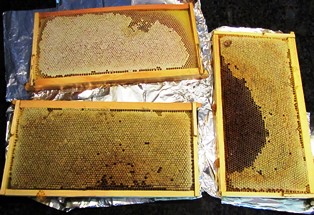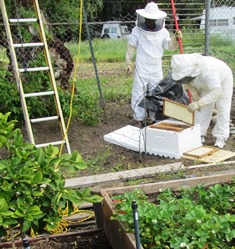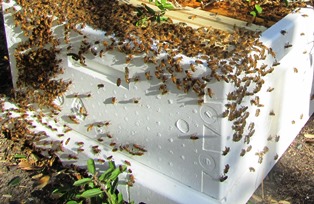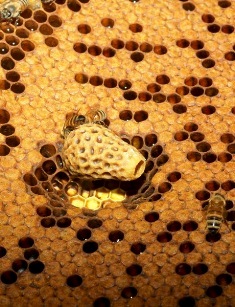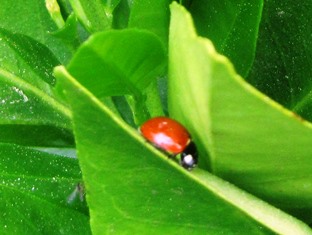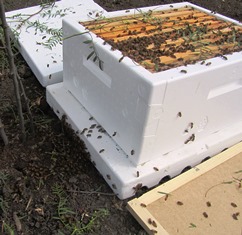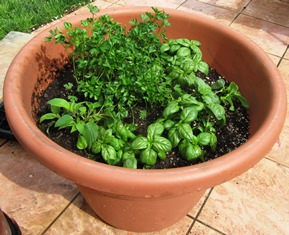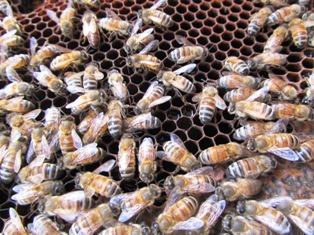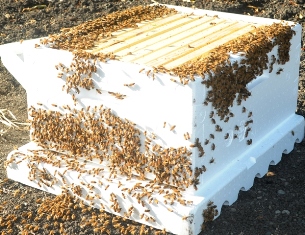Archive for the 'Insects' Category
What to Do When Ants Invade the Honey Bucket
My five-gallon honey bucket with the spigot makes it easy for me to fill up a jar of honey for friends or family. For easy access, I keep it on a round table in the kitchen.
Yesterday morning, I went to refill our own empty jar and noticed ants on the exterior of the bucket. It has a lid on it, but not too tight-fitting, so I held my breath and pulled off the lid.
Removing the lid, I found the ants had infiltrated it and hundreds floated in the honey. Imagine my dismay.
I consulted with my beekeeper neighbor about what to do with the now-unusable honey. Much to my surprise, he said save it. He told me to put it in the freezer (the one specifically used to freeze frames and therefore kill any pests we can’t see on the wax before returning those frames to the hives). So the bucket with the ants went into the freezer I keep on the patio.
My neighbor says the ants will die. The bees can then eat that honey when there isn’t enough pollen around, for example, during the winter. It’s a win-win . . . except for the ants.
A False Swarm . . . Sort Of
When I heard my neighbors banging on a pan with a wooden spoon, I sprang into action. It is what we do when a honeybee hive swarms.
As it turned out, my bees had swooped from the hive with their queen into the front yard, past the plum tree and were circling above the blood orange. My neighbors, who were in their courtyard, saw it and began the banging to confuse the bees so they would alight close to their home.
I ran out and, with direction from my beekeeper neighbor, placed the hive near the orange tree. I’d already placed eight frames with wax and my neighbor brought over two with honey on the comb. All seemed to go as planned. We shook the tree and the bees dropped into the prepared hive.
My neighbor went home, and I went back to my computer and the novel I’m writing. Thirty minutes later, the bees were swarming again. I ran out and banged on the pan. They settled down. All seemed well, except for ants that had been in the orange tree and now were in the hive box.
Around nine o’clock at night, I sprayed the outside of the hive with Windex and wiped it with paper towels. I repeated the procedure around the perimeter of the box, replaced the lid, and carried the hive box back to the apiary believing all would be well. It wasn’t.
This morning, I ran out and suited up in my beekeeper’s outfit and gloves, opened the new hive box, and looked in. To my dismay, all the bees were gone.
My neighbor later told me over coffee that the bees had likely returned to their old hive as small swarms sometimes do. So . . . I suppose I may be repeating this whole scenario at some point in the days ahead. My neighbor reminded me that the weather has been strange, and the weather affects the bees’ behavior.
How My Real Life Informs My Art
Every story needs a setting, a world in which something happens. For my cozy mysteries, I didn’t set out to create a new world for my coterie of characters, I just appropriated details of the life I am living as a farmette dweller.
Daily chores on our Henny Penny Farmette provide plenty of fodder for my fictional stories. Our daily activities include chicken care, garden and orchard work, beekeeping, cooking and preservation of vegetables and fruits, renovating the antiquated farm house, fixing sheds, and building fences and retaining walls.
Stories need a sense of verisimilitude for readers to suspend disbelief and join the fictional journey. Drawing upon my real-life experiences, I can easily integrate my adventures in my books. And not only my activities, but also experiences of my architect husband who is ever-occupied with making our old house more liveable.

In this 1953 photo, our little house sat in a great, big field with not much around it; the dwelling faced Mount Diablo (still does) and the Delta and great central valley lie to the northeast
The tax assessor told me that our dwelling might have been a mining shack in the late 1940s (we live near Mt. Diablo and Lime Ridge where mining and rock quarrying were once important industries). We’ve also been told that our little house might have later served as a farm home (we live less than two miles from designated agricultural farmland). The structure desperately needed updating when we found it almost five years ago. But as settings go, the house and farmette work great.
We have since used recycled and reclaimed materials, sale items at big box DIY stores, and gifts (like lumber, stone, and windows/doors) from friends who do demolition on estates. We’ve visited companies that sell granite and asked for permission to take broken stone from their dumpsters. Thus, we’ve created a lovely bathroom floor with found materials that we’ve cut and sanded.

Light from a crystal chandelier dances off the new granite counter, but the floors were not yet installed when this photo was taken
Of course, the exact details of our daily activities may not make their way into my stories, but versions of them sometimes do. At the very least, such activities inform my storytelling. I daresay the chickens and bees serve important roles in my mysteries. And each new day brings new adventures, from foxes showing up to skunks and raccoons raiding our fruit and nut trees.
Lately, a new chicken showed up on our property (a heritage chicken that had the ability to fly over my neighbor’s fence). She’s been staying here ever since. Wild turkeys often take a path through the property and once or twice a gorgeous stallion named Romeo and its owner ride by and say hello. Such events can add textural details to the setting of a story.
Honeybee Hive Pests Include Real Vampires
Every beekeeper wants to keep his or her hives healthy. Staying on top of your bee’s health means early detection and treatment of pests in the hive such as Varroa mites, trachea mites, hive beetles, and wax moths.
Varroa mites–these small reddish brown pests are akin to tiny vampires, feasting on your bees’ blood. Non-medicinal approaches to treating for these mites include introducing a screened bottom board. Mites fall through and cannot re-enter the hive to reattach to the bees. Also a powdered sugar dusting of your hives’ top bars can dislodge mites.
Tracheal mites–these pests are more difficult to detect. My beekeeper neighbor showed me infant baby bees with partial wings and said he believed it was the work of tracheal mites. To rid your hives of these pests, you’ll need to use menthol crystals and grease patties.
Hive beetles–if you see an insect with a hard, small black shell in corners and dark places within the hive, you may have hive beetles. They devour bee brood, honey, wax, and pollen. Treat the soil in front of the hive and inside the hive, you can try hive beetle traps or treat chemically. The infected honey will be rejected by the bees and should be considered unfit for human consumption as well.
Wax moths–these nasty little creatures can been seen in honeycomb and leave a silky trail over your hive’s hanging frames. If you see evidence that they’ve tunnel into the wood, know that you’ve had the infestation for a while. Wax moths will weaken a colony. Treat the infected hives with moth crystals formulated to eliminate wax moths in the hive.
Hives that are frequently checked their beekeepers stand the best chance for having healthy colonies of bees.
Building A Honeybee House
For my birthday this year, my husband surprised me with some practical beekeeping gifts and a promise to build an attractive bee house to hold our hives. In a plastic, five-gallon honey bucket, he’d placed a beekeeper’s suit, goatskin gloves, and a smoker.
This weekend, he made good on his promise. Although the temps hit 85 on Saturday and Sunday, he suited up in a lightweight beekeeper’s topper with protective netting over the face and got to work measuring, cutting, and securing the waterproofing material, hammering it in place.
With the waterproofing material attached to the roof and sides, he then covered the structure with old fence boards. But it wasn’t easy to mark the cut lines wearing gloves much less cutting the boards with the arm and table saws. He peeled the gloves off.
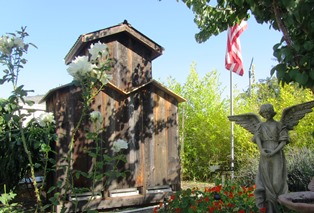
Beekeeper access is through the rear; the upper story holds a supply shelf; bee entrances are at the front bottom
Now, I know one thing about honeybees. Knocking at their door (say, with a hammer) will bring the guards out and they’ll sting . . . which they did.
My husband was on a mission and wasn’t about to let a bee sting stop him. He rubbed the spot with an ice cube, refused to take any Benadry®, and returned to work. But, not before donning some gloves.
But the gloves he put on weren’t beekeeping gloves. They were gardening gloves, good for deadheading roses but not much of a defense against venom-filled stingers.
So, for a little additional insurance against any more bee stings, we lit the smoker to calm the bees a bit. My husband was nearly finished working around the entrance to the hive when one of the honeybees apparently took notice of the fabric portion of the glove and stung right through it.
Even then, Carlos didn’t want to stop working. Only two metal roof sections remained to be cut, placed, and secured along with a shelf for the supplies. But it was sunset. The bees were going in for the night, and we were working in their flight path. We decided to call it a day, too.
The bee house roof will need to be finished before the rainy season starts in November. The good news is that the bees won’t bother Carlos if he stays in back of their house or on the roof. Activity at their front door sends an alarm through the entire colony that a predator is trying to get in. The honeybee defense is to go into attack mode, even if the “predator” in this case is the architect who designed and built their darling little house.
20 Interesting Facts about Honeybees
If your fruit trees, berries, and flowers are flourishing, you can be assured that bees have been busy in your garden. If you are a gardener who lives near a beekeeper, consider yourself really fortunate. Eighty percent of pollination is attributed to bees. Without these industrious little insects, Earth’s plant diversity would be in jeopardy. Here are some other interesting facts about honeybees (apis mellifera).
WORKER HONEYBEES
1. The worker honeybees are sterile females. The workers keep the hive clean, serve as nursemaids to the babies, forage for food, scout for new locations, stand guard at the hive entrance, and care for the queen.
2. The lifespan of a worker bee is 6 to 8 weeks; the queen’s lifespan can stretch to 3 years.
3. In her short lifetime, an average worker bee will produce about 1 1/2 teaspoons of honey.
4. A honeybee will travel about six miles from its hive to forage on nectar- or pollen-rich plants.
5. Honeybees never sleep.
6. During one collection flight, a honeybee will visit between 50 and 100 flowers.
THE QUEEN
7. A honeybee queen is made or created (as opposed to being born). Worker bees secrete royal jelly through the glands in their heads (hypopharynx and mandibular) to feed the larvae. Rich in vitamins and nutrients, the royal jelly may also contain a single protein known as royalactin and scientists believe this ingredient ensures the larva becomes a queen.
8. Newly emerged queens will fight to the death, leaving only one to rule the hive. The honeybee queen lays around 2,000 eggs. These become fully developed in 21 days.
9. The queen doesn’t leave the hive. Her job is to mate with the drones, produce eggs, and serve as matriarch of the colony.
THE DRONES
10. Drones are bigger than the worker bees but smaller than the queen and have rear-ends that are more blunted than round.
11. The drone’s sole purpose is to mate with the queen, which he does in the air. Drones die during mating.
12. Drones do not have stingers unlike the worker bees who have stingers with bee venom.
13. Drones are kicked out of the colony in the autumn when mating season in over because the honey reserves are needed to support the colony’s queen and workers through the winter. The drones are expendable since they don’t forage for food, make honeycomb or honey, care for the babies, clean the hive, or otherwise contribute to the colony.
THE COLONY
14. Honeybees communicate with each other through chemical signals. When there is a predator present, the worker bees release a pherome that communicates to her hive mates the need to attack.
15. The primary swarm (with the old queen) happens in spring and is a colony in transition. Swarming is the method by which the bees leave the hive en masse to establish a new colony. Swarming usually occurs during a two-week period in spring on warm days.
16. A swarm can include 10,000 bees but they are not in attack mode; they are preparing to move to a new home with their queen and are carrying the honey they need for the trip in their stomachs.
17. Honeybee colonies have been around for millions of years. There are fossils of honeybees in European deposits dating back 23 to 56 million years ago.
HONEY
18. Honeybees are the only insects that produce a product that humans eat. Honey is highly nutritious and has many health benefits.
19. Honey never goes bad; honey was found in King Tut’s tomb.
20. It takes more than 500 honeybees collecting pollen from 2 million flowers to make 1 pound of honey.
Swarming Season Has Arrived!
What’s not to love about spring? It’s only the middle of April and already we’ve seen several honeybee swarms. Swarming is how the bees reproduce their colonies and most often occurs during the warm days of early spring.
My neighbor, whom I’ve often called a world-class beekeeper (his father kept honeybees in Lebanon and taught him well) permitted me to keep his bee swarm that alighted in my apricot tree. He also generously donated a super (hive box) with some frames that already had wax, honey, and capped brood–all from his own apiary.
The newly housed honeybee workers delight in foraging on the various types of lavender (Spanish, English, and French perfume) that I’ve planted around the farmette. The colony will build up the wax and make honey while the nursemaid bees will care for the brood.
My husband, the architect-turned-farmer/beekeeper, has constructed a unique bee house for the hives. It will keep the bee boxes dry during winter rains and out of reach of marauding animals (skunks and raccoons). Resting on a platform that Carlos built on top of a newly installed brick floor, the hives are not within easy reach of the ever present ant population.
Alas, the bees weren’t about to wait until Carlos finished building their house. The swarm happened when the bees were ready to take flight (some 60 percent of the workers with their old queen) flew into our apricot tree.
If you see a swarm, call your local beekeeping association (or any store that carries local honey) for the name of a beekeeper. Avoid the temptation of spraying water or anything else on the swarm. Permit the beekeeper to safely remove the swarm.
For a beekeeper, rescuing a swarm is a truly exhilarating experience. Often a swarm consists of thousands to tens of thousands of honeybees. Beekeepers routinely rescue swarms from where bees have temporarily clustered while the bee scouts seek a permanent home. The beekeeper can shake them into a prepared hive box, leaving the box at the hive cluster site until all the bees are inside. At that point, the beekeeper takes the new hive to his apiary.
The beleaguered honeybees (whose populations have been decimated by the Varroa mite, weakened immune systems, and Colony Collapse Disorder) need help to survive and increase their populations. We need them, too! Without their pollination of fruit, nut, and other crops, our own food sources diminish.
Saving the honeybees is a good practice whenever possible because doing so ensures abundance and diversity in the plants we eat. Whenever I see a cluster of bees in a tree I feel joyful and celebratory. Is it any wonder that swarming season is my favorite time of the year?
Have You Planned Your Garden Yet?
Ladybugs and honeybees occasionally meet on the same leaf when both forage for food. The ladybugs dine on aphids while the honeybees seek the sweet nectar of blossoms; orange, tangerine, and lime trees are favorites.
The bug and bee traffic has been steadily increasing now that showers and warm weather have triggered blossoms opening on the fruit and citrus trees around the farmette.
Spring doesn’t officially begin until March 20, but with the weather forecasters predicting upper 70’s Fahrenheit later this week and nighttime temperatures in the 50’s, it is time to consider options for your garden. Many DIY centers are already offering vegetable seedlings, herbs, and berries for planting. Some have markedly discounted their bare-root fruit trees and roses.
I’ve already planted seeds in flats for germination and scattered flower seed (collected from last summer’s flower garden) around prepared beds. When the outside temperatures start to climb, I’ll be rewarded with blooms from nasturtiums, petunias, zinnias, and sunflowers.
The climbing roses are already past the red-leaf stage and are producing the first flush of blooms for spring. The wisteria vines have plump pods ready to unfurl with gorgeous tracts of purple blossoms. And the first green tips of leaves are beginning to sprout on my apples even as the early peaches and apricots already have fruit forming.
This time of year holds the promise of new beginnings, and you see that in every step you take in a garden. Because I prefer to grow plants from varieties of heirloom, open-pollinated seed, I save it from the best specimens grown in the previous season. Of course, some plants freely re-seed themselves. That’s why I now find lettuce and onions and even sweet peas coming up in expected places on the property.
Have you figured out what veggies, flowers, fruits, and berries you’ll plant and grow in your garden this year? If not, now’s a good time to get started. For ideas, check out, http://www.organicgardening.com/learn-and-grow/plan-beautiful-vegetable-garden.
If you prefer, as I do, the non-GMO and organic seeds, there are many excellent sources for them. For heirloom and rare seed, check out http://www.rareseeds.com/store/vegetables/. Also see, http://www.victoryseeds.com/aboutus.html and http://www.anniesheirloomseeds.com/
Telltale Signs of Spring
As I write this, the honeybees are scouting every plant on the property. Awakened by warm weather and sunlight, they search for nectar. Aside from a few California poppies and other wildflowers blooming in front of the house, they won’t find much to forage on just yet.
Of course, there are a few apricot, nectarine, and almond tree blossoms as well as a smattering of white strawberry blooms in the raised beds at the back of our property. But within a few weeks, the warm weather of March and April will render the farmette virtually covered in masses of sweet offerings for the honeybees.
Still, there are the early signs of spring. The Japanese maples are leafing out in a dazzling show of red color. The pregnant stems of our bearded iris are swelling now for their Easter bloom cycle. And the Greek oregano is popping up everywhere as it does this time of year.
Birds are building nests, but I haven’t seen the red-breasted robins just yet. When they show up, searching for worms and grubs, I will know spring has truly arrived. Until then, I look for the telltale signs that Mother Nature is about to robe herself in the splendid garments of spring–fruit tree blossoms, leaves, blooming wildflowers, and lovely kitchen herbs pushing up all over the place.
An Extra Blanket for the Bees
With Thanksgiving only a couple of weeks away, weather is turning downright frosty at night. I asked my beekeeper neighbor if it was time for us to throw some blankets over the hives to help the beleagured honeybees stay warm. We did this last year along with feeding the bees with a good result of thriving hives in the spring.
In the wintertime, the honeybees cluster toward the middle of the hive, their muscles responsible for flight now shivering (albeit in a different way than when taking flight), to generate heat. The colder it gets, the tighter the cluster and harder the bees have to work to stay warm. If the the core temperature of the hive drops too low, the colony will die. See http://indianapublicmedia.org/amomentofscience/honeybees-winter/
During winter months, proper ventilation to maintain a dry hive is a must. Since bees eat and metabolize honey to generate heat, carbon dioxide and water are produced. The carbon dioxide, heavier than air, descends and exits the bottom of the hive while the water vapor rises to the cold inner roof and drips back down as condensate on the poor bees. Freezing and starvation can cause bee die-offs in the winter.
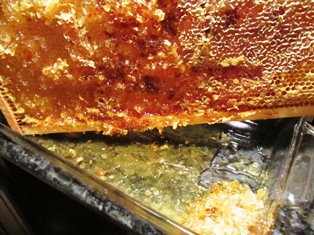
Bees eat and metabolize honey from stores within the hive during winter when outside food sources are scarce
We drape each hive with a blanket over the top and around the back and sides, but not in front where the openings are located. Bees need to be able to enter and exit. As soon as the temperatures warm, my neighbor and I pull back the blankets during the day.
Some might suggest that putting out an extra blanket for the bees is interfering with nature’s processes and survival of the fittest, but on the other hand, the colony has remained strong and healthy over this last year.
Human use of pesticides has wreaked untold harm on the population of these important pollinators. Isn’t it about time, we considered the plight of the bees and did something to help them survive, like planting excellent food sources for every season and giving them medicine when they need it an an extra blanket for warmth? See, http://www.mariasfarmcountrykitchen.com/help-honey-bees-survive-winter/
 Facebook
Facebook Goodreads
Goodreads LinkedIn
LinkedIn Meera Lester
Meera Lester Twitter
Twitter






